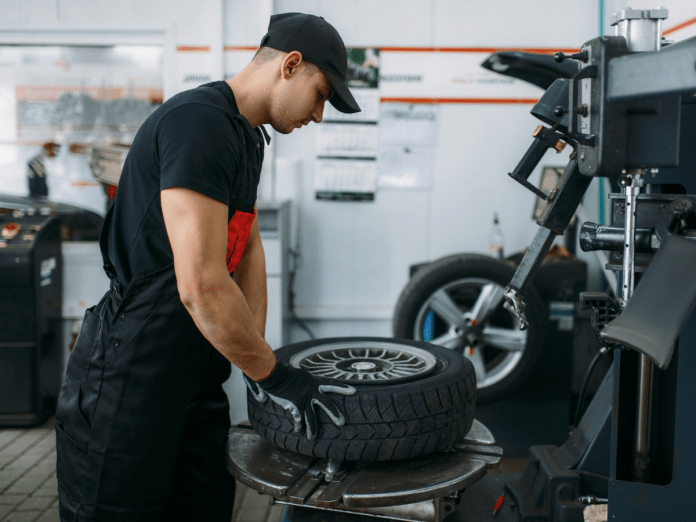Efficient operations and cost-effectiveness are essential for any auto shop or tire service center. One tool that significantly contributes to achieving these goals is a tire mounting machine. Let’s explore how this machine helps in reducing labor costs while improving productivity.
Tire Mounting Machines
Tire mounting machines are specialized equipment used to mount and dismount tires from wheels. These machines automate the process, making tire installation and removal faster and easier compared to manual methods.
How Does It Reduce Labor Costs?
Faster Tire Installation
With a tire mounting machine, tires can be mounted onto wheels much quicker than by hand. This means technicians can complete more tire installations in less time, allowing the shop to serve more customers with the same labor force.
Reduced Physical Strain
Manual tire mounting can be physically demanding and time-consuming for technicians. By using a tire mounting machine, the workload is significantly reduced, leading to less fatigue and fewer breaks needed, thus maximizing the productivity of the workforce.
Minimized Errors and Re-work
Manual tire mounting is prone to human errors, which can result in costly re-work and wasted time. Tire mounting machines ensure precise and consistent tire installations, minimizing the chances of mistakes. This reduces the need for re-work and saves labor hours.
Single-Person Operation
Some advanced tire mounting machines are designed for single-person operation, allowing one technician to handle the entire tire mounting process independently. This eliminates the need for additional manpower, further reducing labor costs.
Streamlined Workflow
By integrating a tire mounting machine into the workflow, auto shops can streamline their operations. With a dedicated machine for tire mounting, technicians can focus on other tasks simultaneously, optimizing overall efficiency and reducing idle time.
Cost-Benefit Analysis
Conducting a cost-benefit analysis is imperative to gauge the financial implications of owning a tire changer. This involves calculating the cost per tire change and considering the frequency of use to amortize the total cost over time. Comparing in-house tire changing with outsourcing services helps determine long-term savings. Furthermore, for businesses, the impact on operational efficiency and customer service should be considered.
Factors Influencing Cost-Effectiveness
Several factors influence the cost-effectiveness of owning a tire changer. The scale of operations, such as personal use versus commercial use, and the frequency of tire changes play a crucial role. Skill and training affect labor costs and in-house expertise. Technological advancements, which offer improved efficiency and automation, come with additional upgrading costs and benefits.
Case Studies or Examples
Real-world case studies and examples play a pivotal role in understanding the practical implications of owning a tire changer. Testimonials from users, industry insights, and trends provide valuable insights into the economic aspects of this investment.
Additional Benefits of Using a Tire Mounting Machine
Improved Customer Satisfaction
Faster service and reduced wait times lead to happier customers. With a tire mounting machine, auto shops can offer quicker turnaround times, enhancing customer satisfaction and loyalty.
Extended Equipment Lifespan
Using a tire mounting machine reduces the wear and tear on manual tools and equipment. This extends their lifespan and reduces maintenance costs, providing long-term savings for the auto shop.
Enhanced Safety
Manual tire mounting poses risks of injuries and accidents due to heavy lifting and repetitive tasks. Tire mounting machines minimize these risks, creating a safer work environment and reducing the likelihood of costly workplace incidents.
Conclusion
In conclusion, a tire mounting machine is a valuable investment for any auto shop looking to reduce labor costs and improve efficiency. By automating the tire mounting process, these machines enable faster installations, minimize errors, and streamline workflow, resulting in significant savings in labor expenses. Moreover, they contribute to improved customer satisfaction, extended equipment lifespan, and enhanced safety in the workplace. Whether you run a small tire service center or a large auto repair shop, incorporating a tire mounting machine into your operations can lead to tangible benefits and long-term cost savings.
FAQs
How much time does it take to mount a tire using a tire mounting machine?
The time required to mount a tire using a tire mounting machine depends on factors such as the machine’s speed and the technician’s skill level. However, it typically takes significantly less time compared to manual methods, often just a few minutes per tire.
Are tire mounting machines easy to operate for beginners?
Yes, many tire mounting machines are designed to be user-friendly and intuitive, making them suitable for technicians of all skill levels, including beginners. Training and familiarization with the machine’s features and functions are usually sufficient for effective operation.
Can a tire mounting machine handle all types and sizes of tires?
Most tire mounting machines are versatile and capable of handling a wide range of tire sizes and types, including passenger car tires, light truck tires, and even low-profile or run-flat tires. However, it’s essential to ensure that the machine’s specifications match the tires you intend to mount for optimal performance and safety.


